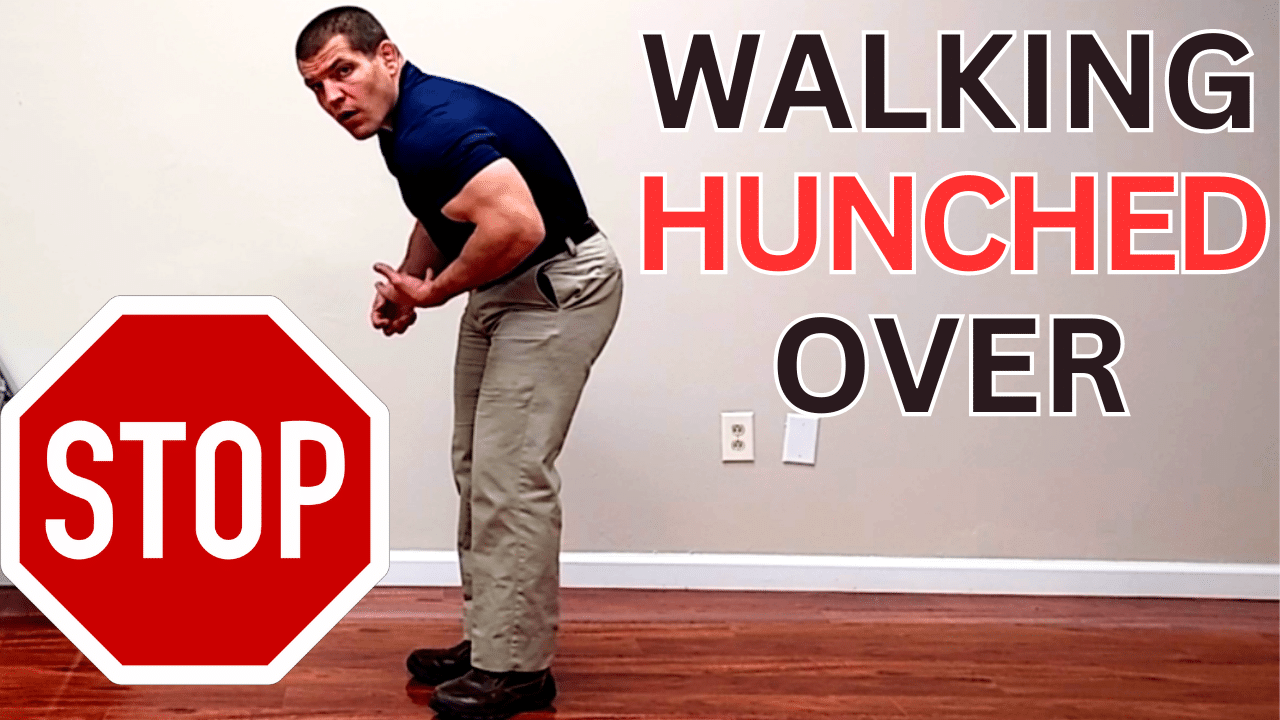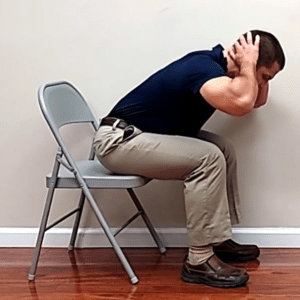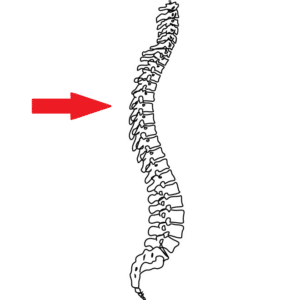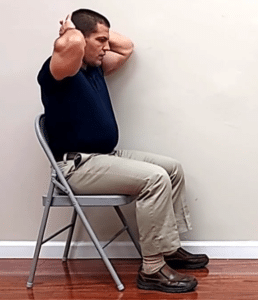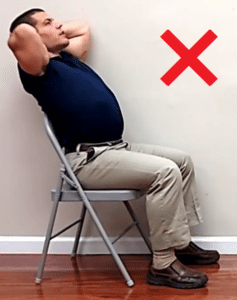Why Do I Lean Forward When Walking?
If you lean forward when walking, you may wonder why you started doing it and how to stop leaning forward when you walk. Watch the video to learn 3 exercises to help you walk more upright. Plus, learn 3 additional tips that you can use to improve your gait, walk with less pain, and decrease your fall risk.

Why Do The Elderly Lean Forward When Walking?
Well, as you age, your back, and particularly your lower back, loses tolerance to standing up tall.
For example, if you have degenerative disc disease, standing upright jams the joints in your lower back together.
This can cause lower back pain when standing. As a result, you may lean forward when walking.
Additionally, standing up tall also narrows the spaces where the nerve roots go down to your legs.
When this happens, it's referred to spinal stenosis, which can give you problems walking.
If your nerves are getting pinched, you may notice pain in your legs when walking.
That's one of the reasons why older adults lean forward when walking.
Because it feels better.
Although walking bent over or leaning on a on a grocery cart relieve pain, you may not like the way it looks
You think it makes you look old if you lean forward when walking.
Or your kids may tell you to stand up and walk taller.
Perhaps it's just their way of getting back at you for nagging them about their posture when they were younger...
Chances are though, that they just want the best for you.
But you really don't want to force standing up and walking taller by arching your lower back.
That just jams the joints in your back and pinches the nerves.
So How Do You Stop Leaning Forward When Walking?
How do you stand upright and walk taller without pinching the nerves in your lower back?
Well, largely it comes from two areas:
- Your hips
- Your thoracic spine
Stiff hip flexors
If your hip flexors are stiff, it makes it hard for you to stand up taller.
As a result, one of two things will happen:
- You'll arch from your lower back (which hurts)
- You'll lean forward when walking
Stiff thoracic spine
Another reason people walk slumped over is due to stiffness in their upper back and chest muscles.
When you round out your upper back, you're looking relatively more downward.
If you spend your career working at a desk you may develop a forward head, rounded shoulders posture. That in turn causes stiffness in your chest muscles, which can make you walk hunched over.
Since you want to see what's ahead of you when walking, most people will try to stand up taller.
However, when you do that from the lower back, then it ends up pinching nerves and joints in your lower back.
Therefore, to be able to stand upright and walk taller, you want to improve your extension from your upper back and from your hips.
3 Exercises To Stop Leaning Forward When Walking
Hip flexor stretches
The first exercise to stop walking bent over is stretching your hip flexor muscles.
One of your hip flexors, the iliopsoas, is actually made of 2 muscles. The psoas portion of the muscle is actually attaches to the front of your spine as shown below.
When your hip flexors are stiff, they tilt your pelvis forwards and pull your spine into an extended position.
Therefore, your choices are either:
- Have back and/or leg pain
- Walk bent over
- Bend your knees and walk like Steve Urkel.
None of those are good options.
Ideally, you want to get the hip flexors stretched out so that you take a step by moving at the hip instead of moving at the back.
The easiest way to stretch your hip flexors is in a standing semi-lunge position. This is especially true for people who have knee arthritis and have pain when kneeling.
- Roll your pelvis underneath you.
- Flatten your lower back out
- Push your hips forward just so you feel a stretch in the front of the hip or the front of the thigh.
- Hold that position for about 30-60 seconds.
If you do have some balance problems, hold on to something to give you a little more stability.
There are other hip flexor stretches as well, so this is just one way to do it.
That's the first exercise to improve your hip flexor flexibility and help you stand more upright from your hips instead of from your lower back.
Thoracic extension exercise
The second exercise is sitting in a chair to improve your upper back flexibility.
If you just try to straighten your back when walking, it's most likely that you'll extend from your lower back, which can cause back pain when walking.
The way that your spine is naturally shaped, it's in an S-shaped curve. The convex side is backwards in your upper back, and the convex side forwards in your lower back.
Therefore, it's easier to extend through the lower back.
But you DON'T want to do that excessively. Doing so jams your facet joints and pinches the nerves that go into your legs.
To lock out your lower back, sit in a chair, and lean forward bringing your rib cage towards your thighs.
Then, to come upright, just lift your chest up so that you're bending backward from the UPPER back (thoracic spine).
This is a SMALL movement.
Note: You don't want to look up towards the ceiling because then you can start to pinch things in your neck.
If for some reason you can't do that, you can also do it kind of sitting back in the chair and arching up over the back of the chair.
This isn't a big movement either. If you move too much you'll start to extend through the lower back.
This exercise you to be able to stand more upright from your upper back instead of your lower back.
Combine those exercises to walk without leaning forward.
When you combine those last two things together, rolling your hips under and then coming up from the chest and shoulders, it makes you more upright without extending through your lower back.
That way you can walk without leaning forward and without causing lower back or leg pain
A counter-intuitive exercise
There is one additional thing that you need to keep in mind, and that's the lower back is the easiest place for you to extend through.
That's because it's naturally already bowed backwards.
It's the easiest for you to move there, so it's the most likely place that you actually will move.
It requires the least energy to stand upright through that area. In general, we tend to move in the patterns that are most energy efficient.
Therefore, in order to be able to stand upright from your hips and trunk, you actually have to stiffen up your lumbar spine.
In other words, tighten your core.
That's kind of counterintuitive because when you tighten your stomach muscles, it actually slumps you over a little bit.
And if you're reading a blog post on how to STOP leaning forward when walking, that's probably the opposite of you actually want.
However, although tightening your core does slump you down a little bit, you'll come upright through the pelvis and the chest and shoulders, so you're just moving at different areas instead of moving at your lower back.
So, those were the three exercises to help you walk more upright and avoid leaning forwards when you walk.
Bonus: 3 Tips To Walk Better With Less Back Pain
I mentioned that I'd share three tips to help you walk better with less back pain as well as be more stable when you walk.
The first tip is to lean forward when walking.
Now, you probably think, "Well, why are you saying that? You just told me how not to lean forward."
Well, this is a little bit different.
You don't want to walk hunched over, but when you're moving, you actually do want your body weight to transfer in front of your feet.
When many people walk, they tend to walk really upright and take large steps with their feet out in front of their body.
But in order to move your body forward, you want to throw your body off balance like that so you take a small step.
So this tip is actually to lean forwards slightly, just enough that your chest and shoulders are in front of your hips and in front of your feet.
Then, instead of pulling yourself forward with the front leg, push off this rear leg to propel yourself forward.
And that brings us to the second point.
Take smaller steps
If you take really large steps, you're going to overstride.
This in turn makes your lower back arch and jams the joints in your back together. This is particularly true if your hip flexors are stiff.
So leaning slightly forward and taking smaller steps as you're walking will help you walk a little bit more comfortably.
In addition, taking smaller steps also decreases your fall risk.
When you're taking really large steps, you have to be single-leg weight-bearing for a long time.
Most falls don't happen when you're on two feet. They happen when you're standing on one leg.
So, if you're taking really large steps, you have to balance yourself on one leg for a longer period of time. If you have weak hip muscles to begin with, then you're going to tip to one side, which throws you off balance and makes you more likely to fall to the side.
So, that's the second tip to help you walk with less pain and to be more stable when you're walking.
The third tip is to swing your arms.
When you swing your arms naturally when you're walking, you move one arm at the same time as the opposite leg, and vice versa.
If you're alternating arms and legs, that gets a little bit of a twisting in your trunk.
If you're worried about either falling forwards or leaning too far forwards, swinging your arms helps counterbalance you.
If one arm is going backward at the same time as the other one is going forward, you're less likely to fall forward.
Conclusion
If you lean forward when walking these exercises can help:
- Stretching your hip flexors
- Thoracic seated thoracic extension
- Doing a standing pelvic tilt
To walk with less pain and improve your balance and stability, try these three tips:
- Lean slightly forward
- Take smaller steps
- Swing your arms
Want To Stop Leaning Forward When Walking?
If you need help to improve your posture, pain, and/or walking ability, we'd be happy to help you at More 4 Life. Just tap the button below to request an appointment with one of our specialist physical therapists.
Like this post? Check out some of our other post about exercises for lower back pain
8 Stretches For Lower Back Pain and Hip Mobility
7 Exercises For Arthritis In Lower Back
The 7 Best Core Strengthening Exercises For Lower Back Pain
Yoga Poses For Lower And Upper Back Pain
Chair Yoga Seniors Can Do For Neck Pain & Back Pain In 7 Easy Poses

